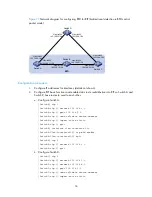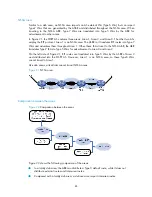
80
OSPF configuration
OSPF is a link state interior gateway protocol developed by the OSPF working group of the IETF.
At present, OSPF version 2 (RFC 2328) is used.
•
The term
router
in this document refers to both routers and Layer 3 switches.
•
Unless otherwise noted, OSPF refers to OSPFv2 throughout this document.
Introduction to OSPF
OSPF has the following features:
•
Wide scope: OSPF supports networks of various sizes and up to several hundred routers in
an OSPF routing domain.
•
Fast convergence: OSPF transmits routing updates instantly upon network topology changes.
•
Loop free: OSPF computes routes with the SPF algorithm to avoid routing loops.
•
Area-based network partition: Splits an AS into different areas to facilitate management. In
addition, routing information transmitted between areas is summarized to reduce traffic and
routing table sizes.
•
ECMP routing: Supports multiple equal-cost routes to a destination.
•
Routing hierarchy: Supports a four-level routing hierarchy that prioritizes routes into intra-
area, inter-area, external Type-1, and external Type-2 routes.
•
Authentication: Supports interface-based packet authentication to ensure the security of
packet exchange.
•
Support for multicast: Multicasts protocol packets on some types of links.
Basic concepts
Autonomous system
A set of routers using the same routing protocol to exchange routing information constitute an AS.
OSPF route computation
OSPF route computation is described as follows:
•
Based on the network topology around itself, each router generates LSA and sends them to
other routers in update packets.
















































